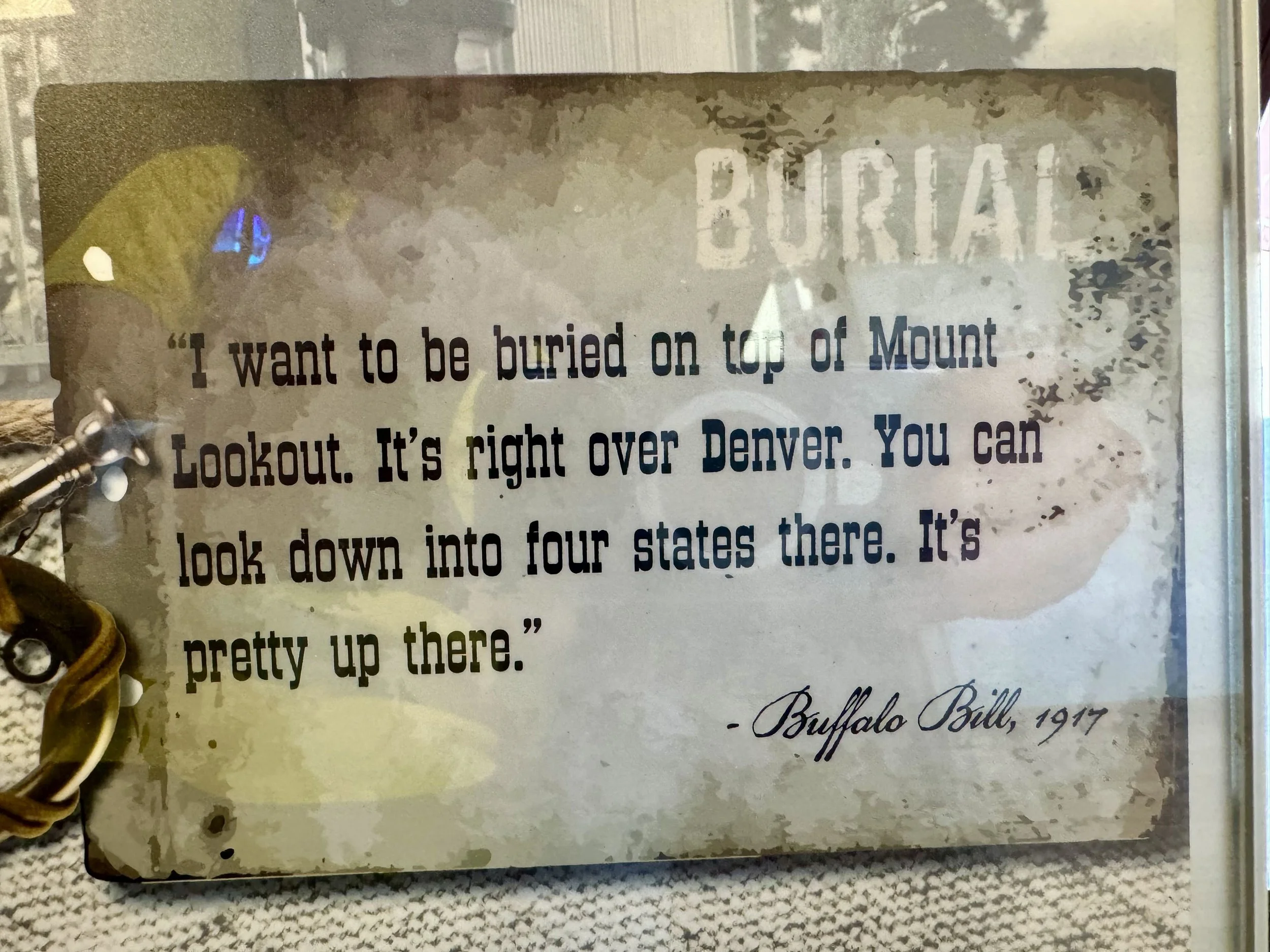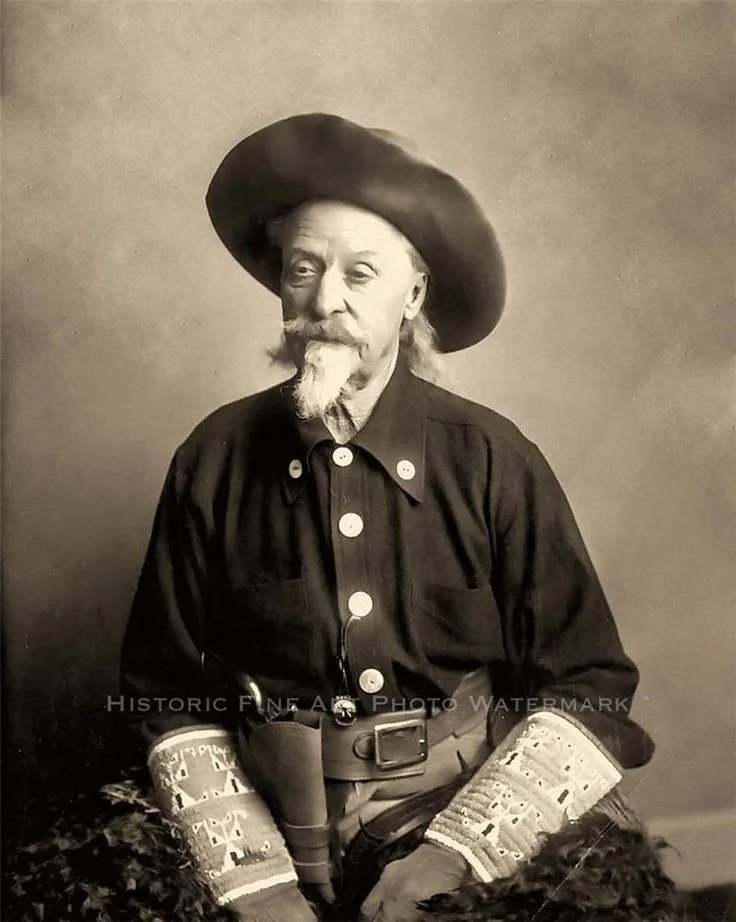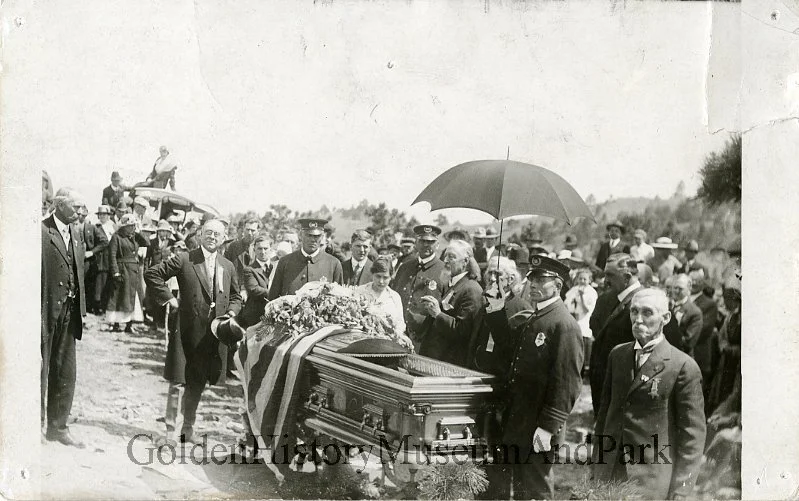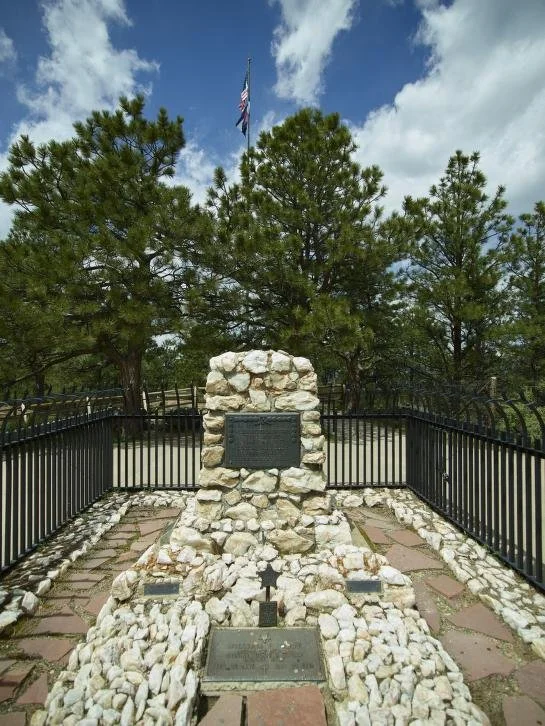The Million-Dollar Grave Robbery Plot
Why Buffalo Bill's Final Resting Place Started an 80-Year War Between Two States
The Bottom Line: Buffalo Bill Cody is definitely buried on Lookout Mountain in Golden, Colorado—but Wyoming has never stopped believing otherwise, leading to armed guards, concrete fortifications, and one of the West's most enduring conspiracies.
Picture this: It's 1948, and the Colorado National Guard is stationed with rifles around a gravesite on Lookout Mountain. Their mission? Protect the remains of Buffalo Bill Cody from a $10,000 bounty (roughly $131,000 today) offered by Wyoming residents determined to "bring their hero home."
This isn't fiction. This actually happened just outside Golden, Colorado, where the most famous showman in American history lies buried—or does he?
The Death That Started It All
On January 10, 1917, William "Buffalo Bill" Cody died from kidney failure while visiting his sister May in Denver. At the time, he was arguably the most famous person on Earth—more recognized than presidents or kings thanks to his Wild West shows that had toured Europe eight times and captivated millions.
But winter had made the road to Lookout Mountain impassable. For nearly six months, Olinger's Mortuary in Denver (now the Linger Eatuary restaurant) kept Buffalo Bill's body in cold storage, embalming it six times to preserve it for the eventual burial. The mortician, Joe Bona, would later say Cody had "fine, big veins" and was "as good a specimen as you could ask for—almost perfect preservation."
On June 3, 1917, Buffalo Bill was finally laid to rest on Lookout Mountain, where he had specifically asked to be buried. The ceremony drew tens of thousands of mourners who made the difficult trek up the steep mountain roads to pay their respects.
The Will That Changed Everything
A quote from Buffalo Bill. He chose Lookout Mountain.
To understand why this controversy exploded, you need to know the complicated story behind Buffalo Bill's final wishes—a tale of changing wills, family loyalty, and financial desperation.
Buffalo Bill's relationship with burial sites was as complicated as his finances. In his earlier wills, he had indeed specified burial near Cody, Wyoming—the town he founded in 1896 and proudly named after himself. The people of Cody naturally assumed their town's founder would return home for his final rest.
But Buffalo Bill voided those earlier wills. Why? His later will left the burial decision entirely to his wife, Louisa—a woman who would soon face an impossible choice between honoring her husband's deathbed wish and solving their crushing financial crisis.
Picture the scene: January 1917, in the Denver home of Buffalo Bill's sister May. The world's most famous cowboy lay dying from kidney failure, just days after learning from doctors in Glenwood Springs that he had less than two weeks to live.
As family gathered around his bedside, Buffalo Bill gazed out the window toward the snow-covered peaks. According to multiple witnesses—including his wife Louisa, daughter Irma, sister Mary Decker, and family friend Johnny Baker—he was struck by the beauty of Lookout Mountain rising above Denver.
"It's so beautiful up there," he reportedly told Louisa. "Promise me you'll bury me on Lookout Mountain."
This deathbed request directly contradicted his earlier Wyoming preferences. But it aligned with something else: Buffalo Bill had always been a showman who understood the power of a dramatic setting. Lookout Mountain offered sweeping views of the Great Plains where he'd made his name as a buffalo hunter and scout—a fitting stage for his final act.
The Money Problem
“Buffalo Bill” Cody, nearing the end of his life.
Here's where the story gets murky. Buffalo Bill died broke.
Despite earning millions from his Wild West shows, the great showman had a talent for bad investments and generous spending. His show had been foreclosed on while playing in Denver in 1908. By 1917, he and Louisa faced crushing debts that his estate couldn't cover.
Enter Harry Tammen—the same circus impresario and Denver Post owner who had contributed to Buffalo Bill's financial ruin. Now, in a twist worthy of Buffalo Bill's own melodramas, Tammen appeared with a solution.
According to Wyoming's version of events, Tammen arrived with Denver mayor Robert Speer and a briefcase containing $20,000 in cash (roughly $520,000 in today's money). Their offer was simple: bury Buffalo Bill on Lookout Mountain, and Denver would pay off his debts and give Louisa enough money to live comfortably.
Did this meeting actually happen? Louisa never confirmed it, but she also never denied it. What we do know is that she left Denver by train for Cody, Wyoming, where the townspeople eagerly awaited their hero's return.
When the train pulled into Cody station, a crowd had gathered to pay their respects. Instead, Louisa delivered devastating news: Buffalo Bill would be buried in Colorado, not Wyoming.
The Betrayal That Launched a Legend
The people of Cody felt betrayed. Their founder, the man who had put their town on the map, was being taken away by slick Denver businessmen who had already ruined him financially. To Wyoming residents, it felt like the final insult—first they took his money, now they were taking his body.
This sense of betrayal explains why the body-swap legend took hold so powerfully in Wyoming. It wasn't just about where Buffalo Bill was buried—it was about justice, loyalty, and the feeling that Denver had stolen something that rightfully belonged to them.
Wyoming's response was as dramatic as any Buffalo Bill show. According to the legend that persists to this day, several of Buffalo Bill's closest friends in Cody—undertaker Fred Richard and his companion Ned Frost—couldn't accept that their mentor would stay buried among strangers who had cheated him.
So they hatched a plan worthy of a Wild West dime novel.
The story goes that Richard and Frost drove the long, dusty road from Cody to Denver under the pretense of paying their final respects to their old friend. But they had another purpose: they'd heard that a local farmhand had recently died—a man who bore some resemblance to Buffalo Bill in build and age.
While at Olinger's Mortuary, they allegedly convinced the mortician to help them switch the bodies. The farmhand went into Buffalo Bill's casket, while the real Buffalo Bill was spirited away in a simple pine box.
"All the way home, they were convinced that the sheriff in every town they drove through was waiting to arrest them," says Bob Richard, Fred Richard's grandson, who still tells the family story decades later.
According to this Wyoming legend, they buried the real Buffalo Bill on Cedar Mountain, overlooking the town he founded—exactly where he had originally wanted to rest.
Meanwhile, Denver proceeded with an elaborate funeral for what Wyoming claims was a farmhand in Buffalo Bill's clothes, none the wiser to the switch.
The Evidence Points to Golden
Mourners surround the open casket of Buffalo Bill Cody.
But here's what actually happened, according to historical evidence:
The Open Casket: Buffalo Bill's June 1917 funeral featured an open casket with thousands of mourners, including family members who had known him intimately for decades. If an imposter lay in that casket, surely someone would have noticed.
The Witnesses: His wife Louisa, daughter Irma, sisters, and close friends like Johnny Baker (his foster son) all corroborated that Buffalo Bill had chosen Lookout Mountain as his final resting place.
The Embalmer's Testimony: Joe Bona, the mortician who embalmed Buffalo Bill, maintained throughout his life that the body he worked on was definitely the famous scout, not an imposter. As the only person who had intimate knowledge of the body's condition, his testimony carries significant weight.
When Legends Became Lawless
Buffalo Bill’s grave.
The controversy might have remained a local dispute, but in 1948, it escalated dramatically. The Cody, Wyoming American Legion Post 26 offered a $10,000 reward to anyone who could steal Buffalo Bill's body and return it to Wyoming.
Colorado took this threat seriously. The Colorado National Guard stationed armed troops around the gravesite. Johnny Baker, Buffalo Bill's devoted foster son who had opened a museum next to the grave in 1921, took even more drastic action. He had Buffalo Bill's casket—and that of his wife Louisa, who had died in 1921—dug up and reburied under tons of concrete.
That concrete fortress remains today, ensuring that wherever Buffalo Bill truly rests, he's not going anywhere.
Most of the controversy actually stems from one person: Buffalo Bill's niece, Mary Jester Allen. After Louisa Cody's death in 1921, Allen began spreading claims that Denver officials had conspired to steal Buffalo Bill's burial rights. Her accusations, combined with Wyoming's genuine disappointment at losing their hometown hero, fueled decades of speculation.
The legend took on a life of its own. In 2006, Wyoming legislators even jokingly debated launching a "clandestine effort" to retrieve Buffalo Bill's remains. The joke highlighted how seriously some Wyoming residents still take this 100-year-old controversy.
Buffalo Bill Days: Celebrating the Legend, Not the Controversy
This weekend (July 25-27, 2025), Golden celebrates its annual Buffalo Bill Days festival, continuing a tradition that started in the 1940s with commemorative trail rides to Buffalo Bill's grave. What began as memorial rides by the Buffalo Bill Saddle Club has evolved into Golden's largest community festival, featuring the famous parade, live music, food vendors, and family activities in Parfet Park.
The three-day celebration doesn't dwell on burial controversies—instead, it honors the spirit of adventure and showmanship that made Buffalo Bill a global icon. It's a chance to experience the same mountain views that convinced Buffalo Bill to choose Lookout Mountain as his final resting place.
Experience Buffalo Bill's Golden for Yourself
Whether Buffalo Bill rests under concrete on Lookout Mountain or secretly on Cedar Mountain, one thing is certain: his story is deeply woven into Golden's history. From his final days in Denver to the museum his foster son Johnny Baker created in his memory, Buffalo Bill's connection to our mountain town runs deeper than most people realize.
Our Wild West Walking Tours include stories about Buffalo Bill's time in Golden and the colorful characters who shaped our town's frontier history. You'll hear tales that go beyond the burial controversy to explore the real relationships and events that connected this American legend to our community.
Ready to explore Golden's Wild West connections? Book your tour directly at goldenhistorytours.com to support our local business and get the best price. Every guest receives our signature Golden Bandana as a lasting memento of your adventure through authentic Colorado history.
Sources
Buffalo Bill Museum & Grave, Denver: https://buffalobill.org/
Denver Public Library Special Collections: https://history.denverlibrary.org/news/western-history/buffalo-bill-cody-really-buried-lookout-mountain
Intermountain Histories, Brigham Young University: https://www.intermountainhistories.org/items/show/469
Park County Travel Council, Cody Wyoming: https://www.codyyellowstone.org/blog/the-mystery-of-buffalo-bill-codys-two-graves/
5280 Magazine: https://www.5280.com/only-in-colorado-buffalo-bills-grave/
Heritage Auctions Johnny Baker Biography: https://historical.ha.com/information/baker.s
Find a Grave Memorial Johnny Baker: https://www.findagrave.com/memorial/6186/johnny-baker
True West Magazine: https://truewestmagazine.com/article/celebrating-buffalo-bill/
Atlas Obscura Buffalo Bill Museum: https://www.atlasobscura.com/places/the-buffalo-bill-museum-and-grave-golden-colorado
GoWorldTravel Buffalo Bill Investigation: https://www.goworldtravel.com/buffalo-bill-golden-cody/
The Dime Library Buffalo Bill Burial: https://www.dimelibrary.com/post/the-burial-of-buffalo-bill
Buffalo Bill Days official website: https://goldenbuffalobilldays.com/
Visit Golden Buffalo Bill Days 2025: https://www.visitgolden.com/events/annual-events/buffalo-bill-days/




